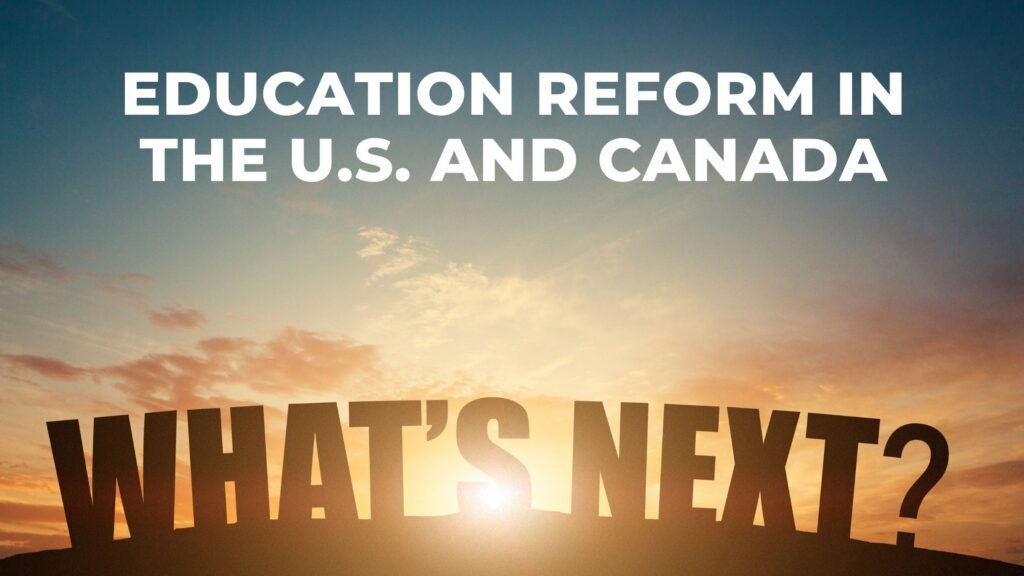Education is crucial to the development of any society since it plays a vital role in training the future generation. But, as the world progresses fast, we need new solutions and approaches in education. The educational reforms in both the U.S. and Canada are at a crossroads. But hold on for a second, what’s this future that everyone is so obsessed with anyway? Do we stand ready for the changes that will be required to provide our students with the skills they will require? A recent survey revealed that 34 % of the students in America have the perception that their education system for future viability is adequate while the same opinion is held by 40 % of the students in Canada. These statistics raise a pressing question: How can these two nations change their education system to ensure that all students are prepared for a successful future?
A Brief History of Education Reforms
It’s often been said that “if one wants to know where he or she is going, the best thing to ask is where he or she has been”. Common themes in the restructuring of educational systems have been the imperatives of equality and equity in the United States and Canada. Employing administrative reform, for instance, the No Child Left Behind Act (NCLB) and the Every Student Succeeds Act (ESSA) has aimed at narrowing down achievement gaps and enhancing the standards of education in the U. S. However, these policies have also been criticized for their over-emphasis on competitive examinations and for not being sufficiently broad.
Canada has experienced more decentralised education reforms with provinces and territories being mainly in charge of the education systems. This has resulted in a variety of approaches, with Ontario; promoting equity and inclusive education, British Columbia; advocating for personalized learning. However, with these reforms, some concerns that have dominated the state, for example, inadequate funding and the increasing need to enhance innovation still exist.
How can Technology help in reformation?
Thus, it can be stated that technology will become one of the major agents of future changes to the organization of education. As with the case of COVID-19, the shift of classes online revealed both the advantages and disadvantages of adopting online learning. In the U. S alone, more than 50 million learners shifted to online learning in the year 2020; it disclosed that society has inequalities in information and communication technologies. Likewise in Canada where digital divide was realized and students in rural and remote areas struggled to attend online classes.
In the successive stages, there is a need for both nations to redress these inequalities and guarantee the efficacy of all learners in the digital contexts. This includes not only offering gadgets and connections but also campaigns aimed at building students’ ability to both use the internet and evaluate the content they are exposed to.
Inclusive Education and addressing Inequalities
Fifty years of ’equal education’ has shown that the education system is still plagued with inequality. In the United States, social inequalities are still reflected in learners’ achievements indicating that learners from poor families and minority backgrounds are likely to experience academic difficulties. The above disparities have been compounded with the COVID-19 pandemic where learners in poor-funded schools have been left behind.
Even in Canada which has been noted to have an equitable context of education, these challenges are well experienced. This excluded group of learners experience poor schooling outcomes and graduation rates lower than the national rates, especially the Indigenous students. To mitigate these gaps, sophisticated inflammatory measures like drawing more resources to poor-performing schools, cultural sensitivity of teachers, and expanding student support services to disadvantaged students will have to be affected.
Role of government and its policies
In conclusion, therefore, it is the policy and the government and the way they will implement the policies that will enhance or mar the education reform in the educational systems of the U. S and Canada. In the United States, the Biden administration has put forward a proposal for a large-scale expansion of the country’s education system including funds to provide Pre-K education to all children, increase community college enrollment, and raise salaries for teachers and subsidies for schools. Thus, reaching these reforms will come only after overcoming political stagnation and developing bipartisanship.
education policy is mainly under the purview of provincial and territorial governments, which causes differentiation in the system. The advantage of this approach is that it provides more targeted solutions according to the requirements of different regions but the disadvantage is how to regulate herein identified problems and guarantee equal service provision and quality across the country.
As such, education has to remain on the policy list of priorities of both nations, with the respective countries bringing enough effort and political will for effective reform processes.
Conclusion
It must address the tensions, stresses, and strains of future education reform. The idea of reforms in the systems of education in the USA and Canada is in a very critical stage now. There are many issues that the two countries have to solve or improve, starting with social injustice and lack of educational opportunities, going through the creation of conditions for innovation, and ending with teacher professional development. But these problems also mean that there is an opportunity to redefine the educational process, according to the needs of learners.
Stakeholders including students, teachers, and communities must be heard moving forward and contribute to the development of education systems that are equal, progressive, and sustainable. Of course, it is difficult to predict the future of education reform but if sufficient ground for its implementation is prepared, it can ensure a better future for students both in the United States and Canada.








Leave a Reply